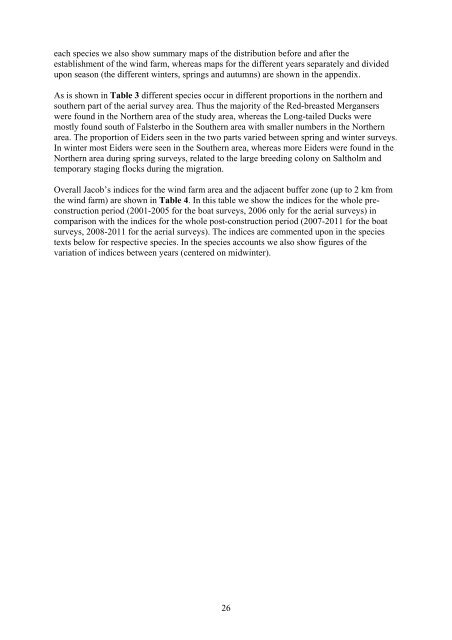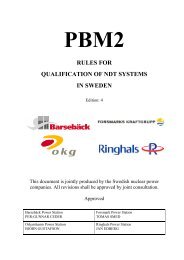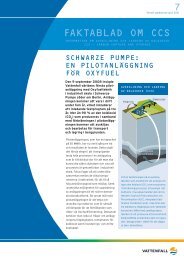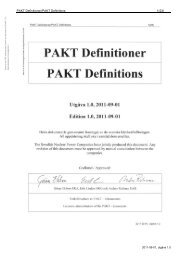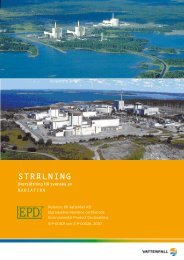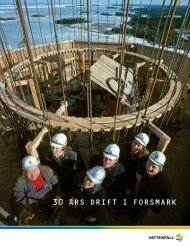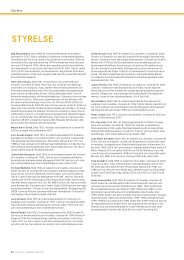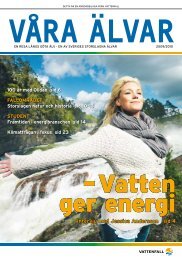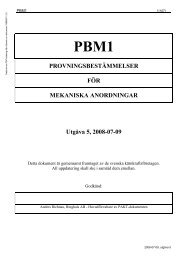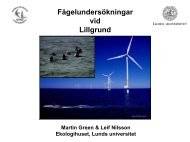Birds in southern Öresund in relation to the wind farm at ... - Vattenfall
Birds in southern Öresund in relation to the wind farm at ... - Vattenfall
Birds in southern Öresund in relation to the wind farm at ... - Vattenfall
You also want an ePaper? Increase the reach of your titles
YUMPU automatically turns print PDFs into web optimized ePapers that Google loves.
each species we also show summary maps of <strong>the</strong> distribution before and after <strong>the</strong><br />
establishment of <strong>the</strong> w<strong>in</strong>d <strong>farm</strong>, whereas maps for <strong>the</strong> different years separ<strong>at</strong>ely and divided<br />
upon season (<strong>the</strong> different w<strong>in</strong>ters, spr<strong>in</strong>gs and autumns) are shown <strong>in</strong> <strong>the</strong> appendix.<br />
As is shown <strong>in</strong> Table 3 different species occur <strong>in</strong> different proportions <strong>in</strong> <strong>the</strong> nor<strong>the</strong>rn and<br />
<strong>sou<strong>the</strong>rn</strong> part of <strong>the</strong> aerial survey area. Thus <strong>the</strong> majority of <strong>the</strong> Red-breasted Mergansers<br />
were found <strong>in</strong> <strong>the</strong> Nor<strong>the</strong>rn area of <strong>the</strong> study area, whereas <strong>the</strong> Long-tailed Ducks were<br />
mostly found south of Falsterbo <strong>in</strong> <strong>the</strong> Sou<strong>the</strong>rn area with smaller numbers <strong>in</strong> <strong>the</strong> Nor<strong>the</strong>rn<br />
area. The proportion of Eiders seen <strong>in</strong> <strong>the</strong> two parts varied between spr<strong>in</strong>g and w<strong>in</strong>ter surveys.<br />
In w<strong>in</strong>ter most Eiders were seen <strong>in</strong> <strong>the</strong> Sou<strong>the</strong>rn area, whereas more Eiders were found <strong>in</strong> <strong>the</strong><br />
Nor<strong>the</strong>rn area dur<strong>in</strong>g spr<strong>in</strong>g surveys, rel<strong>at</strong>ed <strong>to</strong> <strong>the</strong> large breed<strong>in</strong>g colony on Saltholm and<br />
temporary stag<strong>in</strong>g flocks dur<strong>in</strong>g <strong>the</strong> migr<strong>at</strong>ion.<br />
Overall Jacob’s <strong>in</strong>dices for <strong>the</strong> w<strong>in</strong>d <strong>farm</strong> area and <strong>the</strong> adjacent buffer zone (up <strong>to</strong> 2 km from<br />
<strong>the</strong> w<strong>in</strong>d <strong>farm</strong>) are shown <strong>in</strong> Table 4. In this table we show <strong>the</strong> <strong>in</strong>dices for <strong>the</strong> whole preconstruction<br />
period (2001-2005 for <strong>the</strong> bo<strong>at</strong> surveys, 2006 only for <strong>the</strong> aerial surveys) <strong>in</strong><br />
comparison with <strong>the</strong> <strong>in</strong>dices for <strong>the</strong> whole post-construction period (2007-2011 for <strong>the</strong> bo<strong>at</strong><br />
surveys, 2008-2011 for <strong>the</strong> aerial surveys). The <strong>in</strong>dices are commented upon <strong>in</strong> <strong>the</strong> species<br />
texts below for respective species. In <strong>the</strong> species accounts we also show figures of <strong>the</strong><br />
vari<strong>at</strong>ion of <strong>in</strong>dices between years (centered on midw<strong>in</strong>ter).<br />
26


